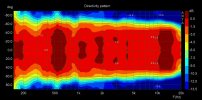First of all; the "CBT effect" is not destroyed when placed close to surfaces. The constant vertical directivity, avoidance of floor reflections, minimization of vertical reflections, and the horizontal directivity are unchanged. However, you have a higher level of specular reflections with close proximity to surfaces as well reinforcement in the lows. Just like any other speakers.
The horizontal directivity in a CBT speaker will vary depending on how the design is. It's possible to have equally a true uniform horizontal directivity as the vertical with the right design. The CBT36 has a generally a much more uniform directivity than most commercial speakers, but it also exhibits some side lobes. The horizontal directivity of the CBT36 is as wide as 180°.
At a certain frequency, baffle step will kick in and the speaker will radiate the sound backwards too. Just like other speakers do. This seems to be starting in the area of 200-300 Hz with the CBT36. In other words, the baffle step is really very low considering the narrow baffle of the speaker! Thus, the speaker does not operate like one single driver in regards to baffle step. Baffle step with one driver in a similar wide enclosure would be at a much higher frequency and therfore start to radiate a lot more energy backward earlier in frequency.
Here's a frequency response measurement in the listening position with the CBT36 placed up against the wall (green graph) vs 1.6m distance from the wall. 1/12 Oct. smoothing if I remember correctly.
And ETCs of both placements, showing the specular energy.
Close to the front wall:
1.6m distance from front wall:

